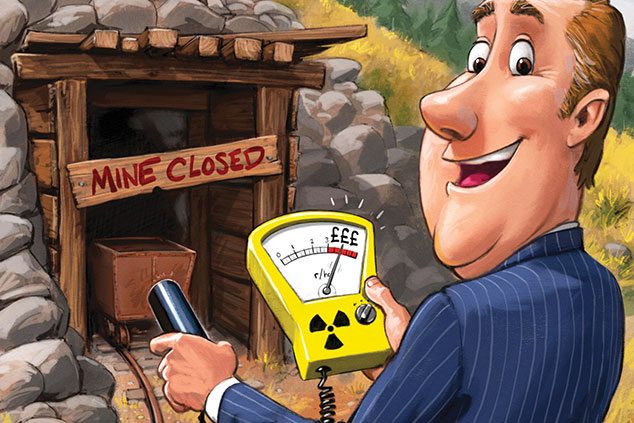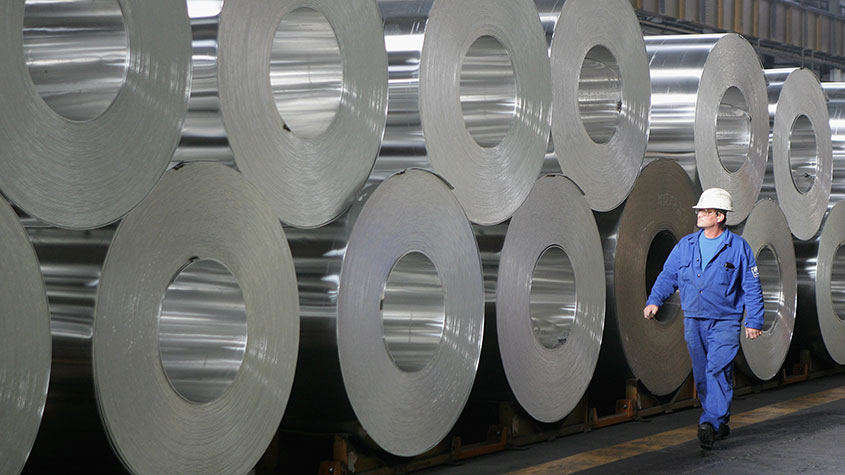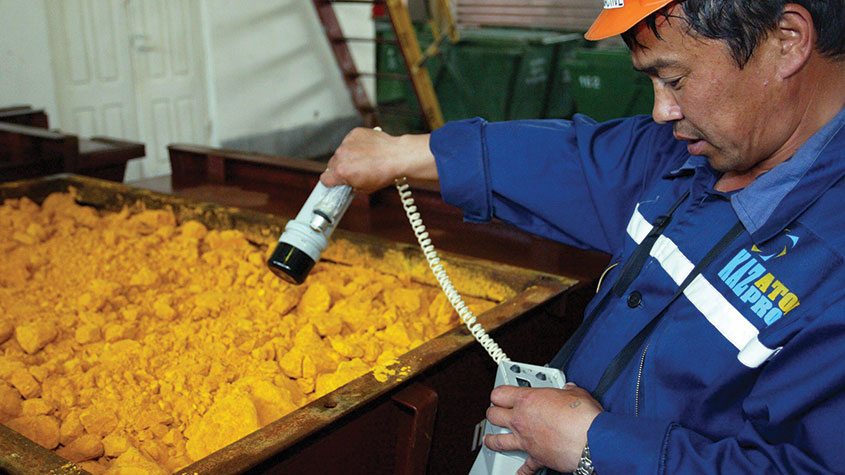The most-hated metal in the world is due a comeback
During the commodities boom, uranium was the bubbliest metal of them all – but the price of the nuclear fuel has collapsed, alongside support for nuclear power. Dominic Frisby asks: is now the time to buy?


A new uranium investment vehicle is set to begin trading on Aim this week. It goes by the name of Yellow Cake, and it's aiming to raise up to $200m at its initial public offering (IPO). This is no cash-starved micro-cap there is serious money involved. So what's its game? And why now, given the apparent deep lack of interest in uranium, and nuclear power generally?
Yellow Cake's business strategy is upfront and straightforward. It thinks that uranium is "structurally mispriced", to use the words of Peter Bacchus, whose boutique investment firm, Bacchus Capital Advisers, is behind the deal. Yellow Cake plans, in essence, to buy uranium, stockpile it, then wait for its price to go up. There will also be royalty and streaming deals (where the company pays a uranium producer upfront in exchange for a stream of future payments from the sale of said uranium).
The vehicle will be the closest thing to a uranium exchange-traded fund (ETF) available in the UK. As an investor, you are not shouldering the risk that comes with investing in a mining company as it attempts to develop a property and, eventually, bring it into production (which can take decades). Rather, Yellow Cake is near enough a pure play on the metal itself. There is a lot to like about the thinking behind this idea (and we will get to the details in a moment). But the bigger question is this: does Yellow Cake have its timing right? Is the bear market in uranium, which began some 11 years ago in 2007, then became deeply entrenched after the Fukushima disaster in 2011, now coming to an end; or is it set to continue for another ten years, to the point at which nobody can even whisper the word "uranium" without uttering a thousand vindictive curses? My instinct tells me that uranium, though it may not be "structurally mispriced", is certainly cheap. But what is cheap can always get cheaper. Bear markets are cruel things.
MoneyWeek
Subscribe to MoneyWeek today and get your first six magazine issues absolutely FREE

Sign up to Money Morning
Don't miss the latest investment and personal finances news, market analysis, plus money-saving tips with our free twice-daily newsletter
Don't miss the latest investment and personal finances news, market analysis, plus money-saving tips with our free twice-daily newsletter
If uranium was scarce, the price would be higher
Let's start with supply and demand. The fact is that many uranium producers simply cannot operate profitably at current prices. Late last year the world's largest publicly traded uranium producer, Cameco, suspended operations at its flagship McArthur River mine in northern Saskatchewan. Almost simultaneously, nationally owned Kazatomprom, the largest producer in Kazakhstan (which, as a country, is the biggest producer of uranium in the world), announced three-year cuts of around 20%. Before the cuts, the two companies between them accounted for almost 40% of world mine supply, according to the World Nuclear Association (WNA). So that should put a dent in stockpiles, which should in turn help to prop up prices.
That said, these cuts were announced in December and the market has thus far barely raised an eyebrow. And on the other hand, the vast Husab mine in Namibia is set to reach full capacity later this summer. This will produce somewhere between 5,000 and 7,000 tonnes of U3O8 (the most stable form of uranium oxide, and the one that the most commonly quoted uranium price refers to) each year. That's around 10% of world mine supply, but most of it will end up in China, I expect, as the company that owns the mine, Taurus Minerals, is part of China Guangdong Nuclear Power. There are other mines coming online that include (potentially) Mulga Rock and Wiluna in Australia; Arrow Canyon in North America (the latter has hit environmental protest problems); and Salamanca in Spain. This is a race Salamanca owned by Berkeley Energia (LSE: BKY) is likely to win.
The reality is that if supply was as constrained as some suggest, the uranium price would be higher. It isn't. Yes, the uranium price does tend to be rather slow to react to changes in conditions, but for as long as it is still trading in the region of $22 or $23 per pound or thereabouts, there is very little profit motive to increase production or open up new mines. But in turn, that also means that the longer the price stays this low, the more bullish the outlook becomes.
The demand outlook
The absence of Japanese uranium consumption since the Fukushima disaster in March 2011 has resulted in stockpiles building up. This has meant that secondary supply has always been available to keep a lid on prices. However, this supply will not last forever, and it's not easy to replace quickly it takes a very long time to bring new uranium development projects into production. And right now, the sector is so starved of capital that many are struggling to tread water, let alone progress. Meanwhile, on the demand side, despite the qualms of many voters in the developed world particularly, nuclear-power capacity worldwide is "increasing steadily", reports the WNA. There are currently 450 reactors in operation, with a further 57 under construction (mostly in Asia). Another 154 are on order or planned, and a further 284 proposed.
About 200 tonnes of uranium are required to keep a typical, large 1,000MW power reactor generating energy. In total, at a global level around 395,000MW of reactor capacity has been installed. That means we need around 79 million tonnes a year of uranium. This is just about met by current mine supply (which is likely to be around 65 million tonnes in 2017) and stockpiles. But the new reactors that are currently under construction will produce another 62,000MW (requiring 12.4 million more tonnes of uranium); and those reactors on order or planned mean a further 158,000MW (31.6 million more tonnes).
So demand is set to increase while the low price means there is no incentive for producers to boost supply. That suggests that higher uranium prices are inevitable, eventually. But that's the key word "eventually". What we all want to know is, "when?" For Yellow Cake, I reckon the timing seems right. When you're building a vehicle of Yellow Cake's size it makes sense to be early. Fortune favours the prepared, and all that. I also suspect that money invested now will return well over a five-to-ten-year horizon. But for shorter-term investors, my sense is that we are still a little early.
I attach a lot of importance to investor psychology, and I can't help but think that the memories of all the money lost in uranium after its post-2007 crash are still too real. Bubbles take a long time to unwind and, boy, was uranium a bubble. The low for the uranium price came in late 2000, at below $10. By 2003 it was still $10. But by the end of 2004, the price had doubled to $20. In 2005 we got lift-off. It had doubled again to $40 by early 2006. By early 2007 it had doubled yet again. And by mid-2007, it peaked at $137.
But this was nothing compared with the performance of some of the mining companies. Take Laramide Resources (Toronto: LAM), which is still developing uranium deposits in Australia and the US proper uranium deposits, I should add, not fly-by-night moose pasture. But, such are the logistics of uranium mine building, that it will probably be at least another ten years from now before it sees actual commercial production. In early 2002 Laramide traded at one cent a share. Barely five years later, in March 2007, it hit C$16.70. Let's just fantasise for a moment that you bought the low and sold the high. A thousand quid became £1.67m. These kind of gains put even dotcom and bitcoin to shame.
Bubbles leave investors with long-lasting scars
The thing is, Laramide was not alone. There was a mania around uranium. Thousands of new companies sprung up to explore for the stuff. Many more rebranded themselves as uranium-focused. You used to go to mining conferences and everyone seemed to be in the uranium game all of a sudden, raising money for this or that project which they were suddenly very excited about, even though they'd never previously mentioned it. The ridiculous thing about all this is that uranium is not an uncommon element what is uncommon is for it to occur in commercially mineable amounts. But at over $100 a pound, what could never, ever become a mine suddenly looked feasible, even if commercial production was light years away.
I remember saying that I was going to stake Wandsworth Common's uranium rights and form Wandsworth Uranium Corp. Some people actually started mulling it over as though it was a serious proposition. In short, it was a proper bubble. And underlying it all was an utterly compelling, believable narrative. An energy crisis was looming. Oil was running out (remember "peak oil"?). Nobody was fracking yet. No new oil discoveries in safe, cheap jurisdictions were being made. Blimey, in those days even the natural-gas price used to go up. Alternative energy could not hope to meet the developed-world's requirements, let alone those of the developing world. Everything was about powering the incredible growth of China, which had to build "x hundred" power stations by some date in the future. So the question was: "where is the uranium going to come from?" No new mines had been built in decades, Russia was no longer selling off its old weapons supplies the easy conclusion was: "quick, buy uranium!" Like all bubbles, once the narrative took hold, the spivs and the scams soon followed.
The bursting of the bubble
The first prick in the bubble came shortly before the financial crisis in 2007. The sector quickly unravelled and most new uranium firms rapidly went out of business as the crisis of 2008 unfolded. But in the commodities boom that followed, uranium had a rebound. By early 2011 it was back trading north of $70, and the narrative that nuclear power was the silver bullet to fix the looming global energy crisis was still strong. Then came the Fukushima disaster. Nuclear-power proponents make the argument that, even though thousands died in the earthquake and tsunami, none of the workers at the Fukushima Daiichi site died from radiation poisoning. In fact, a 2013 Japanese study concluded that the number of fatalities due to "evacuation stress" among the 63,000-odd people who were moved from the area around Fukushima amounted to more than 1,600 but that none of these deaths arose from radiation, increased cancer, or any other direct result of the nuclear accident. Some even argue that the evacuation was a mistake, and that there would have been fewer deaths had people been left to stay at home.
This may or may not be so. Nevertheless, the fears and perceptions around nuclear power, whether misplaced or not, were such that public attitudes towards uranium and nuclear power hardened dramatically. Germany went as far as to say that it would phase nuclear out completely as a power source. Uranium was dead, and any hopes for a resumption in the bull market were done for. The uranium price has been grinding lower ever since.
Yet the slide appears to have found a bottom around the $20 mark. A long, downward grind now seems to have turned into a sideways grind. But public antipathy, justified or not, remains. Meanwhile, if you go to a conference and hear someone making the case for uranium, they're often meet with scepticism. The investment world is not quite ready to hear the story. It is still cynical after the losses.
Jim Mellon, long-time friend of MoneyWeek, rode the bull market perhaps better than anyone. In 2005 he co-founded UraMin with resource investor Stephen Dattels, with $100,000 of seed capital. It floated on Aim in 2006 and was bought by French nuclear giant Areva for €1.8bn a year later at the top of the market. Said to be worth over half a billion pounds, UraMin was Mellon's single greatest investment success. But he sold. Many investors in the last uranium boom didn't or at least, not until it was too late. They're the ones who need convincing now. As far as I'm concerned, it's only a matter of time. Uranium may or may not be quite ready to take off, but it makes sense to book your seat on the plane while it's still going cheap at least research the seat you might book. I look at the most promising options below.
The eight stocks to buy now
One way to play this theme is to go for Yellow Cake itself. The initial public offering is scheduled for 5 July. The firm has signed an agreement with Kazack national miner Kazatomprom to buy up to $170m of uranium at $21.01 per pound (which it will store in Canada). The deal has been flagged for some time and the price of uranium has gone unaffected, so the impact of all this uranium leaving the market is either minimal or it hasn't hit yet. Every year for the next nine, it also has the right to buy up to $100m of uranium from Kazatomprom.
Yellow Cake is following a similar model to Canada's Uranium Participation Corporation (Toronto: U), with whom it's also signed some strategic deals. UPC tends to trade at a premium to its net asset value (NAV the value of the underlying portfolio) currently it's around 15%.
If you want to go for the miners instead, one option that gives you exposure to a number of them is the fund Geiger Counter (LSE: GCL), which invests in some of the main players in the sector. This fund was once the hottest in town, but it has suffered the same fate as uranium and it's a lot smaller and less popular than it once was. It has total gross assets of around £18m (and appears to have given up marketing altogether, which is no surprise, given the antipathy towards the space).
Other possibilities include Canada's NexGen Energy (NYSE: NXE / Toronto: NXE), which, despite the quality of its assets (it has the Arrow Canyon projects), doesn't even mention that it's a uranium miner in the corporate overview on its website. That's another good indicator of the level of apathy among the public and investors towards uranium. Fission Uranium (Toronto: FCU) is another possibility, with an award-winning deposit (it won "discovery of the year" when I was announcing the prizes at the mining awards a couple of years back). I also like UR-Energy (NYSE: URE / Toronto: URE) as it's more bullish about its uranium projects.
If you'd rather stick with London listings, then Berkeley Energia (LSE: BKY) has the Salamanca project in Spain. The stock had a great 2015 and 2016 going against the run of play but it's teetering a bit now (although that may be to do with an exchange-traded fund selling off its holdings). The bet here is that Berkeley can bring its Salamanca mine into production smoothly. I can only ever recall one mining company in all the years I've been investing in the industry that managed this, but you never know.
Finally, of course, there's Laramide (Toronto: LAM) if uranium can catch a bid, it will fly.
Get the latest financial news, insights and expert analysis from our award-winning MoneyWeek team, to help you understand what really matters when it comes to your finances.
Dominic Frisby (“mercurially witty” – the Spectator) is as far as we know the world’s only financial writer and comedian. He is the author of the popular newsletter the Flying Frisby and is MoneyWeek’s main commentator on gold, commodities, currencies and cryptocurrencies. He has also taken several of his shows to the Edinburgh Festival Fringe.
His books are Daylight Robbery - How Tax Changed our Past and Will Shape our Future; Bitcoin: the Future of Money? and Life After the State - Why We Don't Need Government.
Dominic was educated at St Paul's School, Manchester University and the Webber-Douglas Academy Of Dramatic Art.
You can follow him on X @dominicfrisby
-
 Zoopla: house price growth stalled in 2025 but forecasts for 1.5% higher next year
Zoopla: house price growth stalled in 2025 but forecasts for 1.5% higher next yearSales soared this year with more than a million deals done but buyers drove hard bargains keeping a lid on prices. A small bounceback in valuations is predicted for 2026, depending on where you live.
-
 UK sets out crypto regulatory proposals
UK sets out crypto regulatory proposalsThe government has tabled legislation that sets out a regulatory framework for cryptocurrencies, while the regulator will consult on balancing innovation and consumer protections
-
 Invest in space: the final frontier for investors
Invest in space: the final frontier for investorsCover Story Matthew Partridge takes a look at how to invest in space, and explores the top stocks to buy to build exposure to this rapidly expanding sector.
-
 These 2 stocks are set to soar
These 2 stocks are set to soarTips The returns from these two aluminium and tin stocks could be spectacular when the commodity cycle turns says David J Stevenson.
-
 Invest in Brazil as the country gets set for growth
Invest in Brazil as the country gets set for growthCover Story It’s time to invest in Brazil as the economic powerhouse looks set to profit from the two key trends of the next 20 years: the global energy transition and population growth, says James McKeigue.
-
 5 of the world’s best stocks
5 of the world’s best stocksCover Story Here are five of the world’s best stocks according to Rupert Hargreaves. He believes all of these businesses have unique advantages that will help them grow.
-
 The best British tech stocks from a thriving sector
The best British tech stocks from a thriving sectorCover Story Move over, Silicon Valley. Over the past two decades the UK has become one of the main global hubs for tech start-ups. Matthew Partridge explains why, and highlights the most promising investments.
-
 Could gold be the basis for a new global currency?
Could gold be the basis for a new global currency?Cover Story Gold has always been the most reliable form of money. Now collaboration between China and Russia could lead to a new gold-backed means of exchange – giving prices a big boost, says Dominic Frisby
-
 The best ways to buy strategic metals
The best ways to buy strategic metalsTips Weaker prices for strategic metals in the alternative-energy sector are an investment opportunity, says David Stevenson. Here, he picks some of the best ways to buy in.
-
 A lesson for investors from a ill-fated silver mine
A lesson for investors from a ill-fated silver mineAnalysis Mining methods may have changed since the industry’s early days, but the business hasn’t – digging ore from the ground and selling it at a profit. The trouble is, says Dominic Frisby, the scams haven't changed either.
